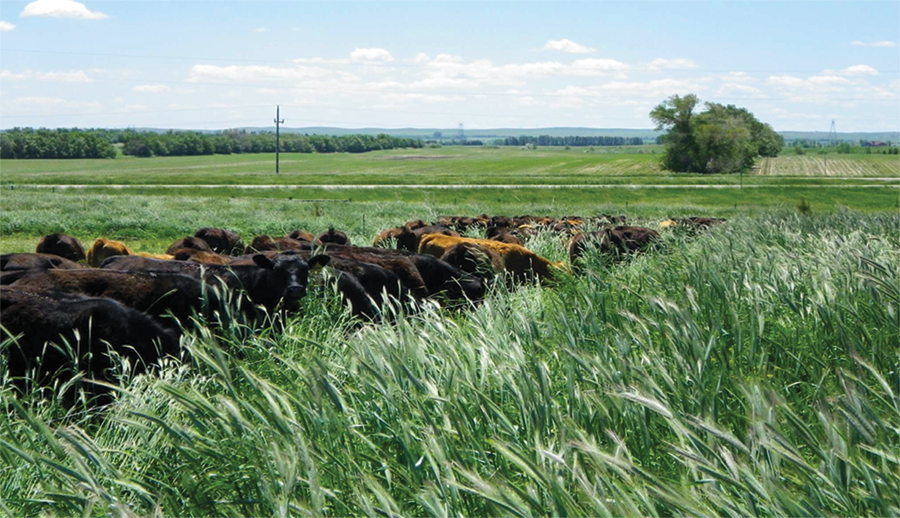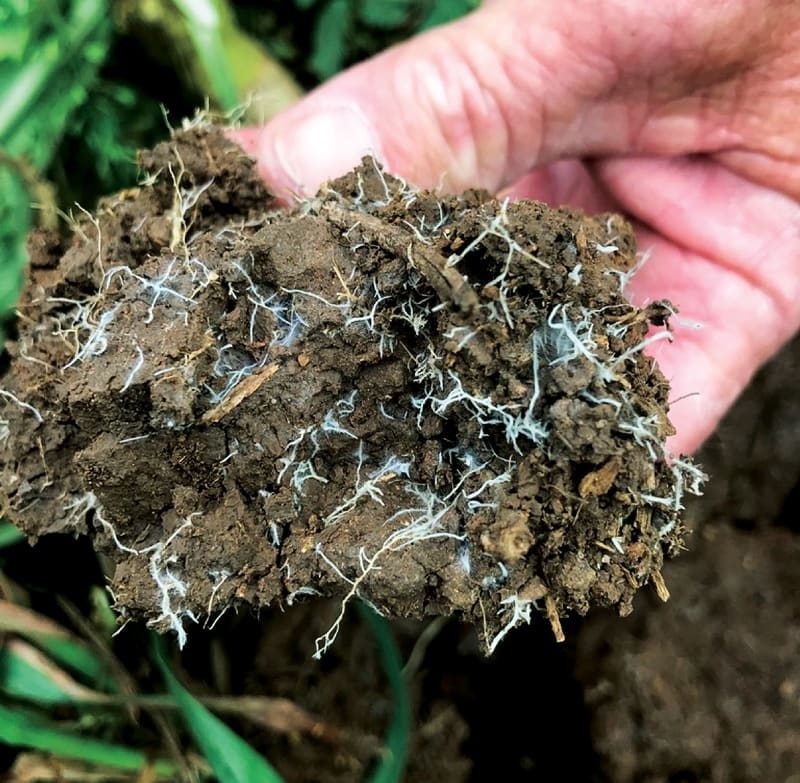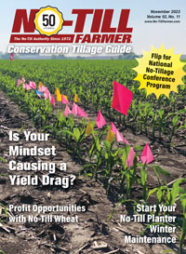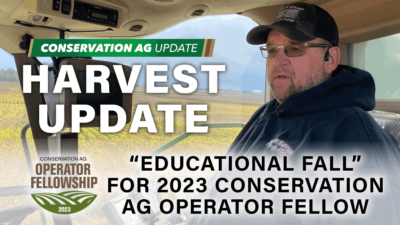Based on the principles of building healthy soil, regenerative ag aims to not only sustain farm productivity but to actually work with nature to regenerate the soil, increase biodiversity and enhance the farming ecosystem.
Maintain Soil Armor
Residue is critical to your soil as it reduces runoff and soil loss, conserves soil moisture, improves soil microorganism populations, increases soil organic matter and improves the soil’s hydraulic and physical properties.
Combine settings are very important to ensure residue is properly processed and distributed evenly throughout the field. You don’t want to over-process residue or it can create a blanket on the surface that may slow soil warm-up in the spring.
Many factors affect the amount of residue you’ll find in your fields, and how long it will hang around.
These factors include crop type; GMO biotech traits; carryover of residue from the previous year; the type of residue processing on your combine; the type and timing of field operations; and soil moisture and exposure to sunlight.
With this large variance between crops, and the impact from all the other factors, residue can vary considerably from farm to farm and from year to year. To protect soil and reap the benefits of maintaining residue, try to maintain residue levels so they don’t impinge on planting and/or early-season crop development.
Minimize Soil Disturbance
According to retired USDA-Agricultural Research Service (ARS) soil scientist Don Reicosky of Minnesota, soil is lost not because we farm, it’s lost because of how we farm.
The career agronomist has done studies that show that a cloud of CO2 rises behind any tillage tool and he says that the invisible gas is indicative of organic matter loss in the soil, a loss that negatively affects soil fertility, water infiltration, soil biology and overall soil structure.
While using a moldboard plow or disk harrow leads to carbon loss by disturbing the soil and the biological activity that enables carbon and nutrient cycling synergies, other traditional farming techniques add to the problem he says.
“As the use of synthetic fertilizer increases, we’re adding more nitrogen to the soil, which increases the mineralization or breakdown of soil organic matter. And, in the case of the upper Midwest, tile drainage allows more oxygen into the deeper soil profiles, and it’s possible that extra oxygen can oxidize more organic matter,” he says.
Add Plant Diversity
While there isn’t enough evidence to show plants actually “talk” to each other, there’s plenty of research that verifies plants play an active role in seeking nutrients, defending themselves from pests and disease, responding to invasive plants and stimulating soil microbial activity, says Kearney, Neb., soil scientist Ray Ward of Ward Laboratories.
Plants emit at least 90 different compounds, or organic chemicals, in responding to environmental conditions, and a host of environmental factors can stimulate a plant to produce and emit one or more compounds to aid that plant in growth or survival, he says.
“When a plant leaks out one of these acids, it’s because the plant is in need of some kind of nutrients, needs to ward off pests and pathogens or aid itself in some way,” Ward says. “Seeking nutrients is a common reason plants exude chemicals.”
The process through which soil microbes deliver nutrients and other elements to plant roots is complex and takes place in the rhizosphere — the region of soil that surrounds —and is influenced by, plant roots.
Chemicals released by plant roots diffuse through the soil, attracting soil organisms that rely on those plant compounds for food. Mycorrhizae, the association plants form with fungi that give them access to soil nutrients and protect against disease, are also part of the process.
“This is a dynamic or symbiotic relationship,” Ward says. “Plant roots produce food that soil microbes need. Soil microbes deliver food or other elements that plants need. It’s a delicate balance.”
Plants not only seek help from surrounding soil but also work with the soil, using biochemical messaging to interact on a level scientists don’t yet understand.
Plant diversity can be achieved by growing a balance of warm-season grasses and cool-season grasses, warm-season broadleaves and cool-season broadleaves, that encompass major plant types that naturally grow in uncultivated regions.
“By promoting an environment in which plants can interact, soil microbial activity can be stimulated by plants, and farmers will benefit in several ways,” Wards says. “They can reduce input costs, because soil microbes can provide more nutrients and more water to plant roots than the plants are able to obtain on their own.
Maintain Continual Living Plant Roots
When left to her own devices, Mother Nature makes sure there is something living and growing in the soil at all times.
In a traditional corn-soybean rotation, there are only active roots in the soil about 32% of the year, leaving the root zone a desert for the remaining 68% of the time. That leaves hungry soil microbes high and dry and organic matter in short supply.
Jim Hoorman, Ohio State Extension educator, says that to achieve the benefits of a more natural cycle, including more efficient nutrient recycling, producers should look to add cover crops to their no-till system.
“In a traditional system, we are only about 30% to 40% effective at recycling nitrogen and 50% effective with phosphorus. Cover crops give us a way to recycle more of those nutrients with active carbon.”
Soil is teeming with life. Microbes, such as bacteria and fungi, are the laborers that keep soil working to a producer’s advantage — and some are more beneficial for certain functions than others.
“Most microbes live close to actively growing roots,” Hoorman says. “If you don’t have anything growing, those microbes die off. No-till helps by not disturbing habitat, but it doesn’t work completely because we haven’t added living roots.
“Add a cover crop and you can build microbial levels and improve your soil.”
Hoorman says fungi are much more efficient than bacteria at storing carbon in the soil. Because fungi don’t handle tillage well, bacteria usually dominate tilled fields while fungi dominate in no-till fields.
“Fungi act like a spiderweb, spreading out and pulling in nutrients,” Hoorman explains. “Mycorrhizal fungi invade the plant root and fungal hyphae penetrate small crevices in the soil. That brings nitrogen and phosphorus to the plant while the plant gives the fungi carbon and simple sugars for energy.
“The fungi contain a substance in their cells called glomalin, which serves as a glue to coat soil particles and promotes good soil structure. No-till soils, especially with a live cover crop, have more glomalin, which improves soil structure and reduces compaction.”

Integrate Livestock
Although regenerative systems don’t necessarily require animals, farmers can add livestock and manage them to accelerate these systems. Having carbon movement as a result of predation on plant leaves is important, says soil microbiologist Kris Nichols, founder of KRIS (Knowledge for Regeneration and Innovation in Soil Systems).
“When a cow grazes, it tugs at the plant and rips off some of the root hairs. The wounded plant needs extra micronutrients to seal its wounds and re-grow, so it releases more carbon into the soil to feed organisms that bring it the extra proteins and enzymes it needs,” Nichols explains.
“It’s a similar process when an insect bites plant leaves. The other important thing that happens when plants seal wounds is that they build more anti-oxidants and polyphenolics, which are also essential to human health.”
Livestock also provide a vital service by returning nutrients in the form of manure back to the land while grazing. This further increases organic matter, activates soil microbial communities and increases nutrient cycling, which are all important to building a health soil.
Related Content
- How Growers Profit from Regenerative Soils: Increasing plant diversity, adding livestock and following a simple soil-testing program can significantly add to the bottom line, growers say.
- Understanding the Carbon Cycle with Don Reicosky: Retired USDA soil scientist Don Reicosky talks about the research he’s conducted over the years, including how he got interested in the carbon cycle and why farmers need to focus on managing it.
- Crop Residue Provides Many Benefits: Learn more about the numerous benefits of leaving crop residue on the soil surface through farm practices such as no till.
- Digging Into the Rhizosphere with Jill Clapperton: Soil health specialist and rhizosphere ecologist Jill Clapperton talks about the importance of no-till in building healthy soil structure. She discusses what happens to soil biology when switching from conventional tillage to no-till, how long it takes to see the benefits of switching, the link between plant diversity and soil structure, and much more.
- Combatting Compaction with No-Till and Cover Crops: NRCS soil health specialist Jim Hoorman explains how improving soil structure with no-till and cover crops can help alleviate compaction problems, including his favorite cover crops for fighting soil compaction.
- Organic Matter Serves Important Role in Soil Health: Of all the components of soil, organic matter is probably the most important and most misunderstood. This article examines the contributions of soil organic matter and talks about how to maintain or increase it.









Post a comment
Report Abusive Comment